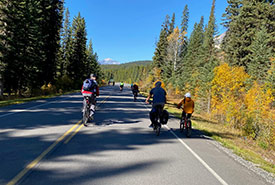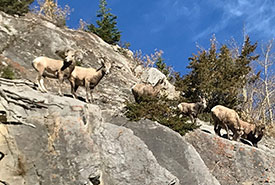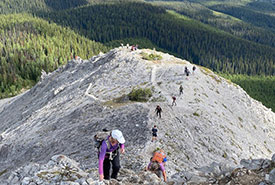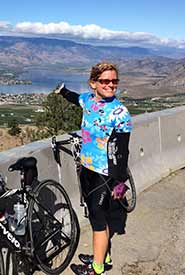The upside of the downside

Families riding along the Bow Valley Parkway (Photo by Gayle Roodman/NCC staff)
I have a confession: I really dislike like the word “staycation.” There’s something about this particular portmanteau that makes me shudder a wee bit every time I hear someone say it. And with COVID-19 wreaking havoc on everyone’s travel plans this year, the word keeps cropping up in vacation-related conversation and I find myself shuddering like a bowl of not-quite-set Jello.
I am grateful to live in a spectacular part of our country. Wilderness, mountains, space, wildlife, trails and mind-blowing scenery await just minutes from my front door.
According to the Nature Conservancy of Canada’s (NCC’s) Nature Score quiz, I’m a Next Level Naturalist. Most weekends you’ll find me playing in the mountains. And then for vacations during “normal” times, I’ll often head out of the country or out of province. But like everyone else this year, the pandemic threw a wrench into things and I had to consider a staycation (shudder!).
Things you can do for a staycation:
Nature Destinations program: Journey through some of the greatest examples of our country’s natural areas and connect with nature.
In a non-COVID year, arriving at a trailhead in the morning, I’m likely to find a few other cars with people who had the same idea. Some people like to adventure in the outdoors where they won’t run into any other humans. I’m not one of those people; I feel more comfortable knowing that there is a small group of people on the same trail, should something untoward happen.
Enter summer 2020, and staycations.

Bighorn sheep (Photo by Gayle Roodman/NCC staff)
The Bow Valley Parkway runs from Banff to Lake Louise, paralleling the TransCanada Highway. This 50-kilometre scenic road boasts oh-so-pretty wildflowers, mountain peaks, the rushing Bow River, picnic spots, trailheads to lookouts and glacial cirques, and the natural sculptures at Johnston Canyon. It’s not uncommon to see a grizzly bear chowing down on a bounty of road-side berries or a herd of Rocky Mountain sheep blocking the road as they lick the salt from the asphalt.
Thanks to COVID-19, Parks Canada closed a 25-kilometre portion of the parkway to vehicular traffic this summer to lessen the number of people stopping at the otherwise very busy tourist attractions. But closed to vehicles meant that this two-lane stunner of a road is open to cyclists and foot traffic. I have ridden this road several times over the last number of years (when the road was open to vehicles), where I’d see maybe a handful of other cyclists over the course of the day.
This past weekend, my husband, two friends and I took advantage of a glorious fall day to ride the entire parkway. The increase in the number of people riding and walking this road was incredible. Families towing kids in Chariots, Lycra-clad roadies (that’d be us), e-bike riders, young kids on city bikes with knobby tires, folks who don’t typically ride a bike and who decided to rent one and give the car-free parkway a go, hikers who parked at the barriers and walked the few kilometres to trailheads. It was wonderful seeing so many people enjoying nature and getting exercise. More than once, we heard people exclaim “They [Parks Canada] should close this every year.”
Tent Ridge is an 11-kilometre ridgewalk offering 360-degree views of the Kananaskis Valley. The return on sweat investment for this hike is what makes it so popular. This summer, my husband and I and a friend (who is in our "bubble") hiked it. We knew about the trail’s popularity, so arrived at the trailhead early to avoid the throngs. It would seem that many, many others had the same plan. We steeled ourselves for what we thought would be an overcrowded trail and worried that we’d have to wear our masks while hiking. What we discovered were hikers of every size, shape and age. The steady stream of hikers picked their way up and over the rocks while respecting physical distancing and displaying patience in waiting for their turn. People courteously stepped off trail to allow other hikers to pass. For some, this was their first hike ever, and after feeling a little stir-crazy at home decided to check out our area’s fabulous parks.

Tent Ridge hiker lineup (Photo by Gayle Roodman/NCC staff)
There are reports across Canada about people flocking to parks and protected areas. Ontario’s Algonquin Park had to stop selling day passes for the fall colours and Stanley Park in Vancouver reported record number of visitors. NCC’s Nature Destinations are also seeing more visitors at some properties. There’s more that needs to be done to educate people about Leave No Trace recreation and the ecological sensitivity of some areas. But this new wave of visitation also creates an opportunity for conservation. My hope is that this is the start of a new love of the outdoors.
Typically, I’d be slightly put-off at large numbers of people heading out on the same trails and exploring nature as me. Like I said earlier, I don’t mind a few fellow adventurers, but jam-packed parking lots tend to make me go “blech.”
But this year has taught me to look at this as the glass half-full.
If staycationing means more people are discovering Canada’s nature for the first time, or deepening their love of our country’s natural spaces, then this can only be a good thing. Bring it on, I say! I wish I could say the same thing, though, for a certain mashed-together word.


